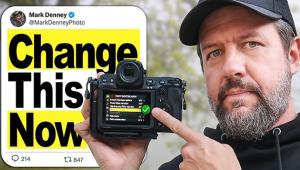Selling Fish; Used SLR Cameras In A Digital World
Photography is a wide-ranging field that engenders passion in its practitioners,
and like all great forms of expression creates opinions formed through experience
and reflection. In its early days one of the great debates was: Is Photography
Art? This was the subject of many essays and heated discussions among players
and spectators. Today, issues such as film vs. digital, format choices, the
validity of computer-generated images, photography as exploitation or revealer,
and even the merits of inkjet vs. silver prints cause similar debate. We are
opening this department up to readers, manufacturers, and retailers--in
short, everyone who lives and breathes photography and who has an opinion about
anything affecting imaging today.
Here's how to get involved: write us an e-mail at editorial@shutterbug.com
or send us a letter with a proposed topic and a synopsis of your idea. Once
approved, we'll ask you to send us about 500-1000 words on the subject
chosen. The idea here is not to push any product or wave any flag, but to create
discussion about photo and imaging topics of the day. We reserve the right to
edit whatever you send in, although we will never edit intention or opinion
but only for length and, hopefully, for clarity. We reserve the right to publish
your work on our website as well, so you can join the archives and be a resource
for opinion for years to come.
So, get thinking and writing and share your Point of View.
--George Schaub
When I worked at Minolta I often joked that selling digital cameras was a lot
like selling fish--whereas selling traditional 35mm film cameras was more
like selling canned goods. The metaphor was obvious, I thought, especially for
the Japanese I worked for. Canned goods keep indefinitely. Fish spoil within
a matter of days. Actually, it wasn't a joke. When I joined Minolta we
were selling SR-T 101 SLRs and had just introduced the new SR-T 201. That was
in 1975, and when I left in 2004 we were still selling lenses that worked perfectly
on those 30-year-old camera bodies. On the other hand, our first consumer digital
camera, the Dimâge V (which featured a revolutionary detachable lens)
became obsolete shortly after its introduction because it required a 5v SSFDC
(also known as SmartMedia) memory card and would not function with the more
modern 3.5v media. As a matter of fact, all variations of that media have essentially
disappeared since then. So despite how exciting and innovative the hardware
might have been when it debuted, it rapidly degenerated into a smelly, dead
fish.
In the '70s, when sales of film camera SLRs peaked at just over the two-million
mark, photographers could rely on a few constants. Number one, of course, was
that film--negative and transparency alike--just kept on getting better.
There were no fancy modifications necessary in order to keep up-to-date with
advancements in film technology. Drop it in, take up the leader, and enjoy the
best that Fuji or Kodak had to offer. Furthermore, the image results depended
to a large extent on the type, speed, and brand of film you used--unlike
today where the media itself has zero influence (excepting write speed). In
other words, an "old" body could be painlessly "updated"
simply by using an improved film type, all else being equal. Not so today.
Another constant--you could start out with an affordable camera model like
a Nikkormat FTN for example, and a couple of years later step up to the high-end
specimen within the same system--in this case a Nikon Photomic FTN--and
be confident of full compatibility. Similarly, you could drop back a generation,
and in most cases, buy a bargain "second body" that would accommodate
all of your lenses.
|
|
|
Camera buyers today are victims of premature obsolescence. I'm not suggesting
that the camera makers are doing anything underhanded--in fact, manufacturers
(and retailers) suffer just as much from this accelerated technological progress
as consumers do. It's expensive to introduce a new camera model. Think
about what it must cost a retailer to remove a camera sample from its display
post and replace it with a slightly better version--especially if they
are a multi-store chain. In many cases this kind of expense is passed on to
the manufacturer--who is already struggling to remain profitable. But everyone
demands the latest and greatest, and to remain competitive, camera makers and
retailers must continue to reach and stretch and innovate.
During the film era, consumers bought into Minolta or Nikon or Canon as a franchise,
and felt assured that they had become part of a system that would never forsake
them except for that once-in-a-blue-moon anomaly when the lens mount changed.
And even then, they usually weren't left completely out in the cold. Today's
digital SLR consumer can't expect much in the way of backward compatibility.
|
|
|
Or can they? To find out firsthand I answered an ad from KEH.com and ordered
a 5-year-old Canon EOS D30, body only, in "EX" condition. When it
debuted in 2001 it wore a price tag of $2995 and photographers--mostly
amateurs but some pros, too--lined up to buy it. And why not? It was one
of the first affordable digital SLRs and it was built exactly like a serious
film camera. In fact, one famous pro used a Canon EOS D30 to shoot a cover story
for People magazine.



































